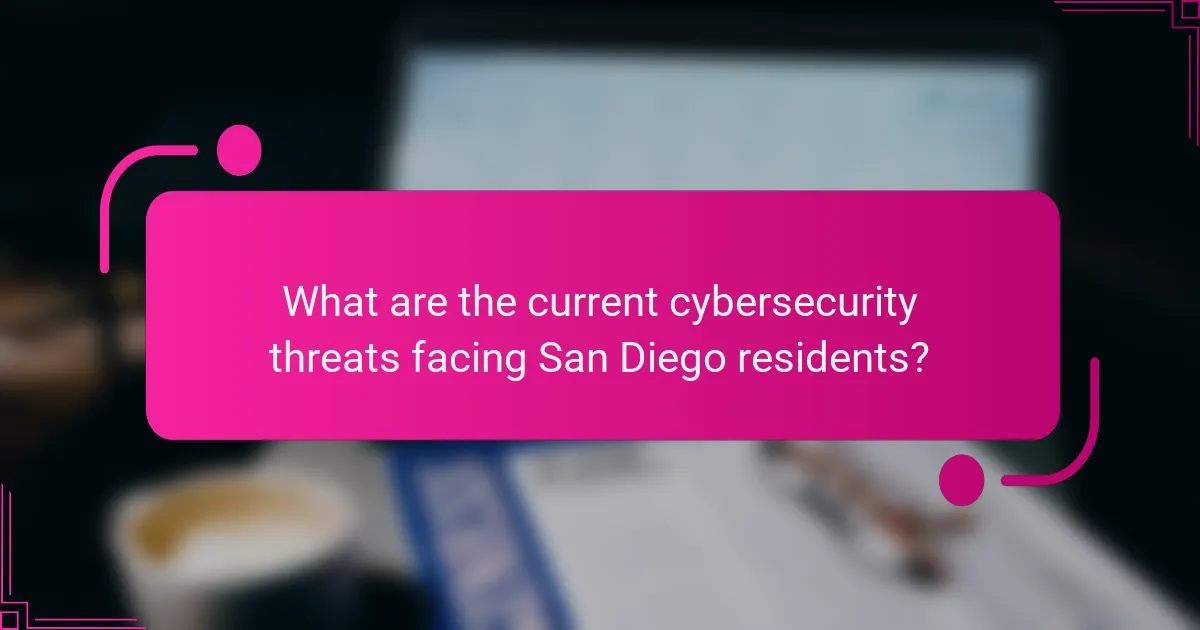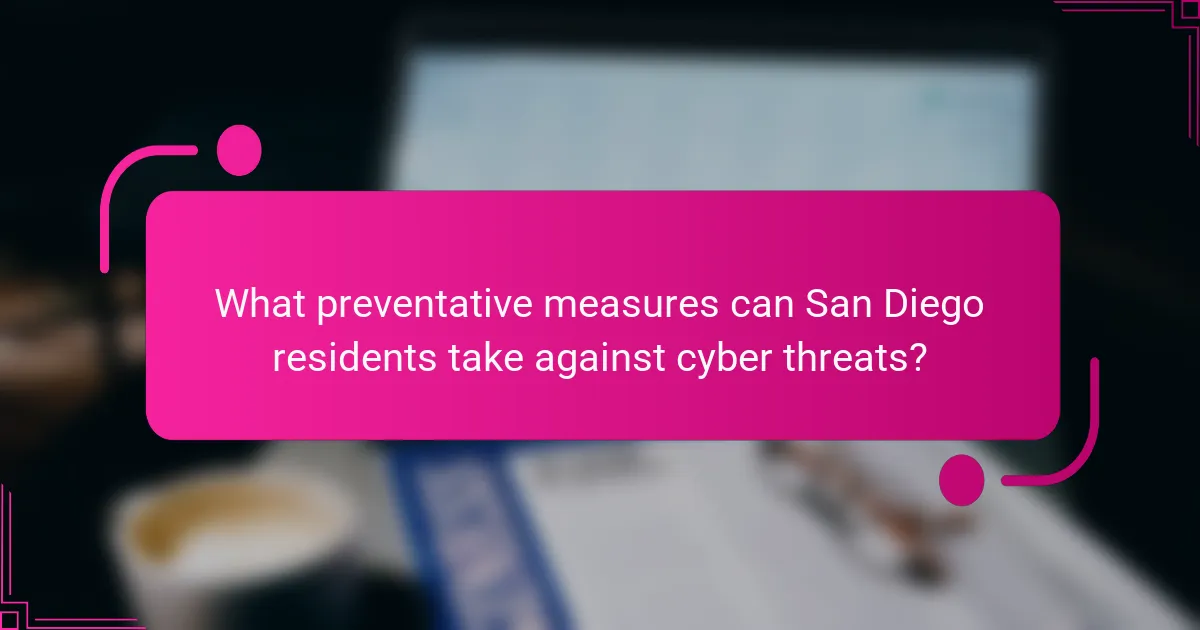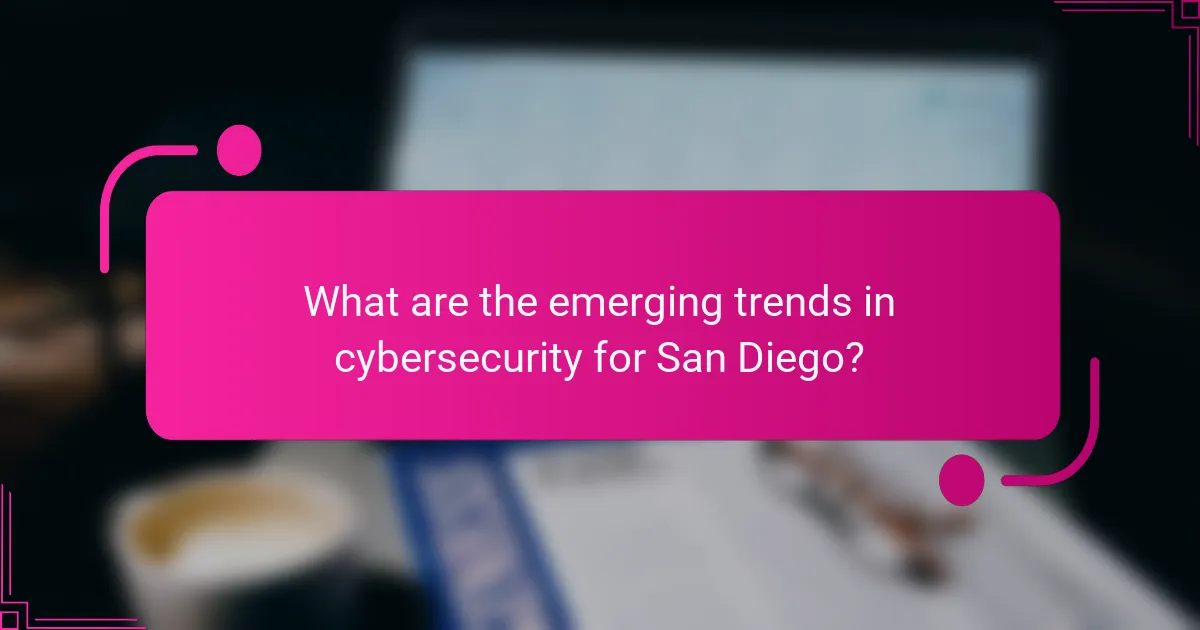
What are the current cybersecurity threats facing San Diego residents?
Current cybersecurity threats facing San Diego residents include ransomware attacks, phishing scams, and identity theft. Ransomware attacks have increased significantly, targeting local businesses and government agencies. Phishing scams exploit email and social media to steal personal information. Identity theft remains a persistent issue, with criminals using stolen data for financial gain. In 2022, the FBI reported a rise in cybercrime complaints in California, highlighting the urgency of these threats. Local law enforcement collaborates with cybersecurity experts to address these issues. Residents are urged to implement strong passwords and be vigilant against suspicious communications.
How do local cyber threats differ from national trends?
Local cyber threats often reflect specific regional vulnerabilities, differing from broader national trends. For example, local businesses may face unique phishing attacks tailored to their community. National trends might highlight larger-scale ransomware incidents affecting multiple states. Local threats can also be influenced by the demographics and industries present in the area. In San Diego, threats may target tourism-related businesses, while national trends could focus on healthcare or finance sectors. Local law enforcement may have different resources and strategies compared to national agencies. This localized focus allows for more tailored preventative measures and responses. Understanding these differences is crucial for effective cybersecurity strategies at both local and national levels.
What specific types of cyber attacks are most prevalent in San Diego?
Phishing attacks are the most prevalent type of cyber attack in San Diego. These attacks often involve deceptive emails that trick individuals into revealing personal information. Ransomware attacks are also common, where malicious software encrypts files and demands payment for access. Additionally, Distributed Denial of Service (DDoS) attacks disrupt online services by overwhelming them with traffic. According to the Federal Bureau of Investigation’s Internet Crime Complaint Center, phishing consistently ranks as the highest reported cyber crime. Local businesses and residents have reported increased incidents of ransomware targeting their systems. Cybersecurity firms in San Diego have noted a rise in DDoS attacks aimed at local companies.
How do these threats impact residents’ daily lives?
Cybersecurity threats significantly disrupt residents’ daily lives in San Diego. These threats can lead to identity theft, resulting in financial loss and emotional distress. Residents may experience unauthorized access to personal data, impacting their privacy and security. Cyber attacks can also disrupt essential services, such as utilities and public transportation. For instance, ransomware attacks on local government systems can halt operations, affecting residents’ access to services. Furthermore, phishing scams can lead to compromised bank accounts, causing financial instability for families. Overall, the pervasive nature of these threats creates a constant state of vigilance for residents, altering their daily routines and peace of mind.
Why is cybersecurity important for San Diego residents?
Cybersecurity is crucial for San Diego residents to protect personal and financial information. The city faces unique cyber threats due to its technology sector and military presence. In 2021, California reported over 1.3 million identity theft cases, highlighting the risk. Local businesses are also targeted, as 43% of cyberattacks aim at small companies. Moreover, a significant number of residents engage in online activities, increasing vulnerability. Effective cybersecurity measures can mitigate these risks and safeguard community trust. Awareness and education about cybersecurity can empower residents to take proactive steps.
What are the potential consequences of ignoring cybersecurity?
Ignoring cybersecurity can lead to severe consequences. These include data breaches that expose sensitive information. Businesses may face financial losses due to theft or fraud. Reputational damage can occur, leading to a loss of customer trust. Legal repercussions may arise from non-compliance with regulations. Operational disruptions can hinder business continuity. Cyberattacks can result in costly recovery efforts. According to a 2021 report by IBM, the average cost of a data breach is $4.24 million. Overall, neglecting cybersecurity poses significant risks to individuals and organizations.
How does cybersecurity affect personal privacy in San Diego?
Cybersecurity significantly impacts personal privacy in San Diego by protecting sensitive information from unauthorized access. Effective cybersecurity measures reduce the risk of data breaches that can expose personal details. In 2021, the City of San Diego reported over 1,000 cyber incidents, highlighting the need for robust cybersecurity practices. These practices include encryption, firewalls, and regular software updates. When residents implement these measures, they enhance their personal privacy. The California Consumer Privacy Act also mandates transparency in data handling, further supporting privacy. Therefore, strong cybersecurity directly correlates with improved personal privacy for San Diego residents.

What preventative measures can San Diego residents take against cyber threats?
San Diego residents can take several preventative measures against cyber threats. They should use strong, unique passwords for all accounts. Implementing two-factor authentication adds an extra layer of security. Regularly updating software and devices helps protect against vulnerabilities. Residents should also be cautious of phishing emails and suspicious links. Using a reputable antivirus program can detect and remove malware. Public Wi-Fi should be avoided for sensitive transactions. Lastly, regularly backing up data ensures recovery in case of a cyber incident. These practices collectively enhance cybersecurity and reduce risks.
How can residents protect their personal information online?
Residents can protect their personal information online by implementing strong passwords and using two-factor authentication. Strong passwords should be unique, complex, and at least 12 characters long. Two-factor authentication adds an extra layer of security by requiring a second form of verification.
Additionally, residents should regularly update their software and devices to mitigate vulnerabilities. Keeping antivirus software up to date also helps in detecting and removing threats.
Using secure networks is crucial; residents should avoid public Wi-Fi for sensitive transactions. They should also be cautious about sharing personal information on social media.
Finally, residents should monitor their financial statements and credit reports regularly for any unauthorized activity. These steps collectively enhance online security and reduce the risk of identity theft.
What best practices should be followed for password security?
Use strong, unique passwords for each account. A strong password typically includes a mix of uppercase letters, lowercase letters, numbers, and special characters. Avoid using easily guessable information like birthdays or names. Change passwords regularly to reduce the risk of unauthorized access. Implement two-factor authentication when available. This adds an extra layer of security beyond just the password. Use a password manager to securely store and generate complex passwords. This practice helps in managing multiple accounts without compromising security. Regularly review account activity for any unauthorized access. According to the Cybersecurity & Infrastructure Security Agency, following these practices significantly reduces the risk of account breaches.
How can residents identify phishing attempts?
Residents can identify phishing attempts by recognizing common signs. Phishing emails often contain urgent language that prompts immediate action. They may include suspicious links or attachments that can compromise security. Check for misspellings or poor grammar, which are frequent in phishing messages. Legitimate organizations usually have professional communication. Residents should verify the sender’s email address for authenticity. Phishing attempts may use addresses that mimic real organizations but contain slight variations. Hovering over links before clicking can reveal misleading URLs. According to the Anti-Phishing Working Group, 75% of phishing emails are designed to look legitimate. Awareness of these signs can significantly reduce the risk of falling victim to phishing.
What tools and resources are available for cybersecurity in San Diego?
San Diego offers various tools and resources for cybersecurity. Organizations like the San Diego Cyber Center provide training and support. The Cybersecurity and Infrastructure Security Agency (CISA) offers guidelines and best practices. Local universities, such as San Diego State University, have cybersecurity programs. The San Diego chapter of the Information Systems Security Association (ISSA) hosts events and networking opportunities. Additionally, the San Diego Regional Economic Development Corporation promotes cybersecurity initiatives. These resources help residents enhance their cybersecurity awareness and practices.
Which cybersecurity software is recommended for personal use?
Norton 360 is recommended for personal use in cybersecurity. It offers comprehensive protection against malware, phishing, and ransomware. Norton 360 includes features like a firewall, VPN, and password manager. It also provides real-time threat protection and performance optimization tools. According to independent tests, Norton consistently ranks high in malware detection rates. Its user-friendly interface makes it accessible for non-technical users. Additionally, it offers 24/7 customer support for assistance. These attributes make Norton 360 a reliable choice for personal cybersecurity.
How can local organizations assist residents in improving cybersecurity?
Local organizations can assist residents in improving cybersecurity by providing education and resources. They can offer workshops on safe online practices. These workshops can cover topics like password management and phishing awareness. Organizations can also distribute informational materials. This includes brochures and online guides tailored to local threats. Collaborating with law enforcement can enhance community outreach. They can host events to raise awareness about cybersecurity risks. Additionally, local organizations can create support networks for reporting incidents. This helps residents feel empowered to take action against cyber threats.

What are the emerging trends in cybersecurity for San Diego?
Emerging trends in cybersecurity for San Diego include increased focus on cloud security, artificial intelligence integration, and enhanced regulatory compliance. Cloud security is becoming vital as more businesses migrate to cloud services. Artificial intelligence is being utilized for threat detection and response automation. Regulatory compliance is tightening, particularly concerning data privacy laws. Local businesses are investing in cybersecurity training for employees to mitigate human error. Additionally, ransomware attacks are on the rise, prompting organizations to strengthen their defenses. These trends reflect a proactive approach to address evolving cyber threats in the region.
How is technology evolving to combat cyber threats?
Technology is evolving to combat cyber threats through advanced security measures and innovative tools. Artificial intelligence is increasingly being used to detect unusual patterns in network traffic. Machine learning algorithms analyze vast amounts of data to identify potential threats in real-time. Next-generation firewalls offer enhanced protection by inspecting encrypted traffic. Endpoint detection and response solutions provide continuous monitoring of devices for suspicious activity. Cloud security technologies are improving data protection through encryption and access controls. Cybersecurity frameworks are being updated to address emerging threats and vulnerabilities. Regular software updates and patches are essential for maintaining security against evolving cyber threats.
What role do artificial intelligence and machine learning play in cybersecurity?
Artificial intelligence (AI) and machine learning (ML) are crucial in enhancing cybersecurity measures. They analyze vast amounts of data to identify patterns indicative of security threats. AI systems can detect anomalies in network traffic that may signify a breach. Machine learning algorithms improve over time, adapting to new threats as they emerge. This adaptability makes them effective against evolving cyberattack techniques. According to a report by Cybersecurity Ventures, AI-driven cybersecurity solutions can reduce response times to incidents significantly. These technologies also automate routine security tasks, allowing human analysts to focus on more complex issues. Overall, AI and ML play a pivotal role in proactive threat detection and response in cybersecurity.
How can residents stay informed about new cybersecurity threats?
Residents can stay informed about new cybersecurity threats by following reputable cybersecurity news sources. Websites like Krebs on Security and the Cybersecurity & Infrastructure Security Agency (CISA) provide timely updates. Local community organizations often host workshops and seminars on cybersecurity. Social media platforms can also be useful for real-time alerts. Participating in local cybersecurity groups fosters information sharing among residents. Subscribing to newsletters from cybersecurity firms keeps individuals updated on emerging threats. Additionally, following local law enforcement social media accounts can provide alerts on regional threats. Awareness campaigns by local government can further enhance knowledge on cybersecurity risks.
What practical tips can residents implement for better cybersecurity?
Residents can implement several practical tips for better cybersecurity. First, use strong, unique passwords for all accounts. A strong password should include a mix of letters, numbers, and symbols. Second, enable two-factor authentication wherever possible. This adds an extra layer of security beyond just a password. Third, keep software and devices updated regularly. Updates often include security patches that protect against vulnerabilities. Fourth, be cautious of phishing emails and suspicious links. These can lead to malware or data breaches. Fifth, use a reputable antivirus program. This can help detect and remove malicious software. Finally, secure your home Wi-Fi network with a strong password. An unsecured network can be an easy target for cybercriminals. Following these tips can significantly enhance residents’ cybersecurity posture.
How can regular software updates enhance security for residents?
Regular software updates enhance security for residents by patching vulnerabilities in software. These updates address known security flaws that hackers exploit. For instance, the 2020 Microsoft Exchange Server vulnerabilities affected thousands of organizations until patched. Regular updates also improve overall system performance and functionality. According to a 2021 report by Cybersecurity & Infrastructure Security Agency, timely updates can reduce the risk of cyber attacks significantly. By ensuring that systems are up to date, residents can protect their personal information and sensitive data more effectively. Regular updates create a stronger defense against evolving cyber threats.
What steps should residents take if they suspect a cyber attack?
Residents should immediately disconnect their devices from the internet if they suspect a cyber attack. This action prevents further unauthorized access. Next, they should document any unusual activity they observe. This includes taking screenshots or noting specific times and actions. Residents should then run a full antivirus scan on their devices. This helps identify and remove any malicious software.
Following this, they should change passwords for critical accounts, especially financial ones. Strong, unique passwords enhance security. Residents should also alert their internet service provider about the suspected attack. Providers often have resources to assist with such incidents. Lastly, if personal information has been compromised, residents should consider placing a fraud alert on their credit reports. This step protects against identity theft.
San Diego cybersecurity encompasses the local threats and preventative measures that residents face in a rapidly evolving digital landscape. Key cybersecurity threats include ransomware attacks, phishing scams, and identity theft, with local businesses and government agencies being primary targets. The article highlights the differences between local and national cyber threats, prevalent attack types, and their impacts on residents’ daily lives. It also emphasizes the importance of cybersecurity awareness, effective practices for protecting personal information online, and emerging trends in technology aimed at combating these threats. Residents are encouraged to adopt specific preventative measures to enhance their cybersecurity posture and stay informed about new risks.